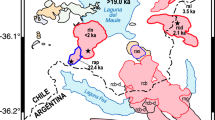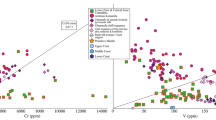Abstract
An undeformed glomeroporphyritic andesite from the Sunda Arc of Java, Indonesia, contains zoned plagioclase and amphibole glomerocrysts in a fine-grained groundmass and records a complex history of adcumulate formation and subsequent magmatic disaggregation. A suite of xenocrystic zircon records Proterozoic and Archaean dates whilst a discrete population of zoned, euhedral, igneous zircon yields a SHRIMP U-Pb crystallisation age of 9.3 ± 0.2 Ma. Quantitative microstructural analysis of zircon by electron backscatter diffraction (EBSD) shows no deformation in the inherited xenocrysts, but intragrain orientation variations of up to 30° in 80% of the young zircon population. These variations are typically accommodated by both progressive crystallographic bending and discrete low angle boundaries that overprint compositional growth zoning. Dispersion of crystallographic orientations are dominantly by rotation about an axis parallel to the zircon c-axis [001], which is coincident with the dominant orientation of misorientation axes of adjacent analysis points in EBSD maps. Less common <100> misorientation axes account for minor components of crystallographic dispersion. These observations are consistent with zircon deformation by dislocation creep and the formation of tilt and twist boundaries associated with the operation of <001>{100} and <100>{010} slip systems. The restriction of deformation microstructures to large glomerocrysts and the young magmatic zircon population, and the absence of deformation within the host igneous rock and inherited zircon grains, indicate that zircon deformation took place within a low-melt fraction (<5% melt), mid-lower crustal cumulate prior to fragmentation during magmatic disaggregation and entrainment of xenocrystic zircons during magmatic decompression. Tectonic stresses within the compressional Sunda Arc at the time of magmatism are considered to be the probable driver for low-strain deformation of the cumulate in the late stages of initial crystallisation. These results provide the first evidence of crystal plastic dislocation creep in zircon associated with magmatic crystallisation and indicate that the development of crystal-plastic microstructures in zircon is not restricted to high-strain rocks. Such microstructures have previously been shown to enhance bulk diffusion of trace elements (U, Th and REE) in zircon. The development of deformation microstructures, and therefore multiple diffusion pathways in zircon in the magmatic environment, has significant implications for the interpretation of geochemical data from igneous zircon and the trace element budgets of melts due to the potential enhancement of bulk diffusion and dissolution rates.









Similar content being viewed by others
References
Cherniak DJ, Watson EB (2003) Diffusion in zircon. In: Hanchar JM, Hoskin PWO (eds) Zircon. Reviews in mineralogy and geochemistry, vol 53. Mineralogical Society of America, Washington, pp 113–143
Chichagov AV, Varlamov DA, Dilanyan RA, Dokina TN, Drozhzhina NA, Samokhvalova OL et al (2001) MINCRYST: a crystallographic database for minerals, local and network (www) versions. Crystallogr Rep 46:876–879. doi:10.1134/1.1405882
Compston W, Williams IS, Meyer C (1984) U-Pb geochronology of zircons from lunar breccia 73217 using a sensitive high mass-resolution ion microprobe. J Geophys Res 89:B525–B534. doi:10.1029/JB089iS02p0B525
Cummins GL, Richards JR (1975) Ore lead isotope ratios in a continuously changing earth. Earth Planet Sci Lett 28:155–171. doi:10.1016/0012-821X(75)90223-X
Davidson J, Turner S, Handley H, Macpherson C, Dosseto A (2007) Amphibole “sponge” in arc crust? Geology 35:787–790. doi:10.1130/G23637A.1
Davis DW, Krogh TE, Williams IS (2003) Historical development of zircon geochronology. In: Hanchar JM, Hoskin PWO (eds) Zircon. Reviews in mineralogy and geochemistry, vol 53. Mineralogical Society of America, Washington, pp 145–181
Dell’Angelo LN, Tullis J (1988) Experimental deformation of partially melted granitic aggregates. J Metamorph Geol 6:495–515. doi:10.1111/j.1525-1314.1988.tb00436.x
Dell’Angelo LN, Tullis J, Yund RA (1987) Transition from dislocation creep to melt-enhanced diffusion creep in fine-grained granitic aggregates. Tectonophysics 139:325–332. doi:10.1016/0040-1951(87)90107-7
Dickin AP (2005) Radiogenic isotope geology. Cambridge University Press, p 508
Grimmer H (1980) A unique description of the relative orientation of neighbouring grains. Acta Crystallogr A 36:382–389. doi:10.1107/S0567739480000861
Hall R (2002) Cenozoic geological and plate tectonic evolution of SE Asia and the SW Pacific: computer-based reconstructions, model and animations. J Asian Earth Sci 20:353–431. doi:10.1016/S1367-9120(01)00069-4
Hazen RM, Finger LW (1979) Crystal structure and compressibility of zircon at high pressure. Am Mineral 64:196–201
Hinthorne JR, Anderson CA, Conrad RL, Lovering JF (1979) Single-grain 207Pb/206Pb and U/Pb age determinations with a 10 μm spatial resolution using the ion microprobe mass analyser (IMMA). Chem Geol 25:271–303. doi:10.1016/0009-2541(79)90061-5
Holness MB (2005) Spatial constraints on magma chamber replenishment events from textural observations of cumulates: the Rum layered intrusion, Scotland. J Petrol 46:1585–1601. doi:10.1093/petrology/egi027
Hoskin PWO, Schaltegger U (2003) The composition of zircon and igneous and metamorphic petrogenesis. In: Hanchar JM, Hoskin PWO (eds) Zircon. Reviews in mineralogy and geochemistry, vol 53. Mineralogical Society of America, Washington, pp 27–62
Hough PV (1962) Methods and means to recognize complex patterns. US patent 3069654
Humphreys FJ, Bate PS, Hurley PJ (2001) Orientation averaging of electron backscattered diffraction data. J Microsc 201:50–58. doi:10.1046/j.1365-2818.2001.00777.x
Humphreys MCS, Blundy JD, Sparks RSJ (2006) Magma evolution and open system processes at Shiveluch Volcano: insights from phenocryst zoning. J Petrol 47:2303–2334. doi:10.1093/petrology/egl045
Kinny PD, Maas R (2003) Lu-Hf and Sm-Nd isotope systems in zircon. In: Hanchar JM, Hoskin PWO (eds) Zircon. Reviews in mineralogy and geochemistry, vol 53. Mineralogical Society of America, Washington, pp 327–341
Leroux H, Reimold WU, Koeberl C, Hornemann U, Doukhan JC (1999) Experimental shock deformation in zircon: a transmission electron microscopic study. Earth Planet Sci Lett 169:291–301. doi:10.1016/S0012-821X(99)00082-5
Ludwig KR (2003) User’s manual for Isoplot 3.00: a geochronological toolkit for Microsoft Excel. Berkeley Geochronology Center Special Publication 4
Mantle GW, Collins WJ (2008) Quantifying crustal thickness variations in evolving orogens. Correlation between arc basalt composition and Moho depth. Geology 36:87–90. doi:10.1130/G24095A.1
Nelson DR (1997) Compilation of SHRIMP U-Pb zircon geochronology data, 1996. In: vol. Geological Survey of Western Australia, Record, 1997/2. pp 189
Pietranik A, Koepke J, Puziewicz J (2006) Crystallization and resorption in plutonic plagioclase: implications on the evolution of granodiorite magma (Gesiniec granodiorite, Strzelin Crystalline Massif, SW Poland). Lithos 86:260–280. doi:10.1016/j.lithos.2005.05.008
Prior DJ (1999) Problems in determining the misorientation axes, for small angular misorientations, using electron backscatter diffraction in the SEM. J Microsc 195:217–225. doi:10.1046/j.1365-2818.1999.00572.x
Reddy SM, Timms NE, Trimby P, Kinny PD, Buchan C, Blake K (2006) Crystal-plastic deformation of zircon: a defect in the assumption of chemical robustness. Geology 34:257–260. doi:10.1130/G22110.1
Reddy SM, Timms NE, Pantleon W, Trimby P (2007) Quantitative characterization of plastic deformation of zircon and geological implications. Contrib Mineral Petrol 153:625–645. doi:10.1007/s00410-006-0174-4
Reddy SM, Timms NE, Eglington BM (2008) Electron backscatter diffraction analysis of zircon: a systematic assessment of match unit characteristics and pattern indexing optimization. Am Mineral 93:187–197. doi:10.2138/am.2008.2658
Reiners PW (2005) Zircon (U-Th)/He thermochronometry. In: Reiners PW, Ehlers TA (eds) Low-temperature thermochronology: techniques, interpretations and applications. Reviews in mineralogy and geochemistry, vol 58. Mineralogical Society of America, Washington, pp 151–179
Smyth HR, Hamilton PJ, Hall R, Kinny PD (2007) The deep crust beneath island arcs: inherited zircons reveal a Gondwana continental fragment beneath East Java, Indonesia. Earth Planet Sci Lett 258:269–282. doi:10.1016/j.epsl.2007.03.044
Smyth HR, Hall R, Nichols GJ (2008) Cenozoic volcanic arc history in East Java, Indonesia: the stratigraphic record of eruptions on a continental margin. In: Draut AE, Clift PD, Scholl DW (eds) Formation and applications of the sedimentary record in arc collision zones. Geol Soc Am Spec Publ 436: 199–222
Timms N, Kinny P, Reddy S (2006) Enhanced diffusion of Uranium and Thorium linked to crystal plasticity in zircon. Geochem Trans 7:10. doi:10.1186/1467-4866-7-10
Whittaker JM, Müller RD, Sdrolias M, Heine C (2007) Sunda-Java trench kinematics, slab window formation and overriding plate deformation since the Cretaceous. Earth Planet Sci Lett 255:445–457. doi:10.1016/j.epsl.2006.12.031
Acknowledgements
The Australian Research Council (via Grant DP0664078) and Curtin University (via a Targeted Research Fellowship to SMR) are thanked for funding this research. Auke Barnhoorn and Bill Collins are thanked for constructive reviews of the manuscript. The fieldwork and sample collection in East Java was funded by the SE Asia Research Group, Royal Holloway University of London as part of H.R.S’s PhD studies. Thanks are extended to Robert Hall for PhD supervision, LIPI, who provided visas and fieldwork permissions and LEMIGAS who acted as counterpart agency. This paper is The Institute for Geoscience Research (TIGeR) publication No. 117.
Author information
Authors and Affiliations
Corresponding author
Additional information
Communicated by B. Collins.
Rights and permissions
About this article
Cite this article
Reddy, S.M., Timms, N.E., Hamilton, P.J. et al. Deformation-related microstructures in magmatic zircon and implications for diffusion. Contrib Mineral Petrol 157, 231–244 (2009). https://doi.org/10.1007/s00410-008-0331-z
Received:
Accepted:
Published:
Issue Date:
DOI: https://doi.org/10.1007/s00410-008-0331-z




